I won the Zion 100 ultramarathon!!! Strava wankers can find it here.
I went into the race with a good amount of trepidation. I hadn’t finished a 100-mile event since Angeles Crest in 2016. My training leading up to Zion was much different than the training leading to my other 100-mile finishes… less volume, but more focus on heavy weightlifting, mobility, and structured speedwork 2x per week.
My training, in a nutshell, amounted to nearly 800 miles of running with nearly 100,000 ft of vertical gain in 2019 leading up to the race. I tapered for two 50k’s that I raced in February and March. The Zion 100-mile race started on Friday, April 12.
Early in the year, while I was building volume from an average of 40 to ~80 miles per week, I focused on developing strength via deadlifts and squats. Per recommendations by Jay Dicharry in his book Running Rewired, I targeted sets of deadlifts at 150-175% of my bodyweight, and sets of squats at 125% (I only reached 125% of bodyweight toward the end of my strength-building phase). I did sets of each exercise once per week, usually on the mornings of days that I would do my speed workouts.
In the 6-8 weeks prior to the race, I spent two days per week in the gym for sauna and hiking practice. I would spend 30-45 minutes hiking stairs or 15% treadmill incline, then sit for 20-30 minutes in the sauna after the hike session. My peak week, 4 weeks prior to Zion, had slightly over 100 miles and 15,000ft climb with the hiking sessions added.
I PR’d my 50k at Way Too Cool in 3:46:12 6 weeks prior to Zion. This gave me a good gauge on my fitness for ultra distances. Based on my execution at Way Too Cool, I decided that I wanted to target an 8.5-hour first 50 at Zion. I formed a race plan with best-case-scenario race splits to run an 8.5-hour first 50 miles. I would see my crew at Goosebump Aid (miles 11, 22, and 28), Virgin Desert (mile 53), and Virgin BMX (miles 80 and 98).
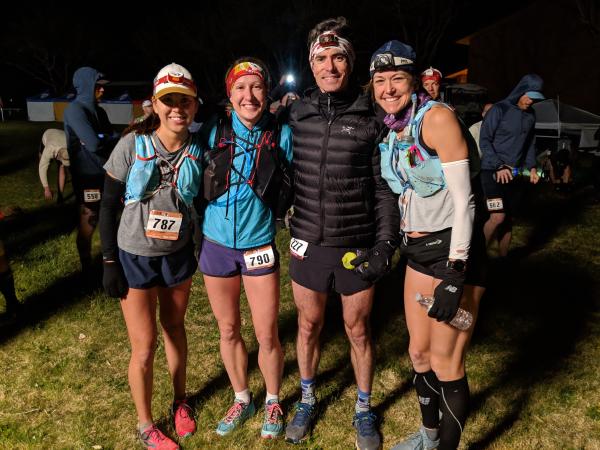
Photo at the start with friends! Katie and Gwen took 1st and 2nd in the 100k!
I set out with the front of the pack. Given that we all set out in the dark, I couldn’t see which of the frontrunners had 100k bibs vs. 100-mile bibs. I settled in the top 5 or so with a relaxed 7:20 mile pace for the first couple flat miles. On the first climb, a massive 1,500ft ascent up to Gooseberry Mesa, I dropped a few places. It worked out in my favor as the first aid station sent runners in the wrong direction; when we all heard a motorcycle rider behind us yelling “Wrong Way! Turn Around!” I was fortunate to turn around sooner than the fastest guys. Fortunately, that blunder was the only issue I encountered with course markings for the entire race, and it set me back less than two miles.
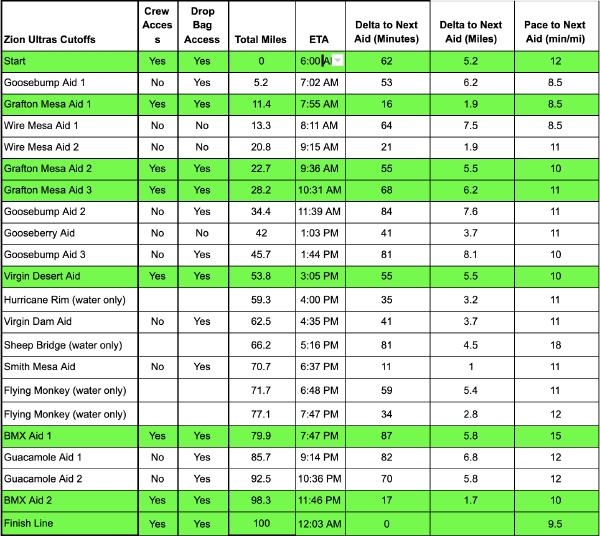
Chris's race plan. Besides a small math error at the 80-mile point, I was spot on for the splits!
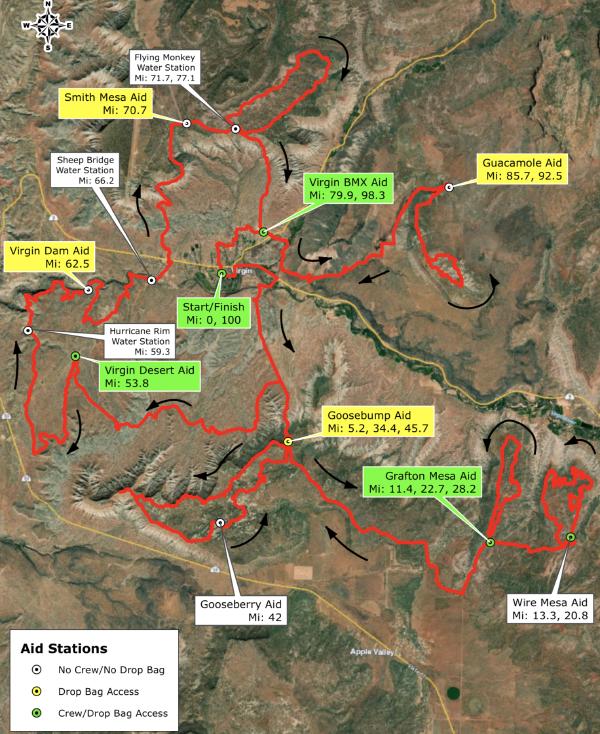
The Zion 100-mile race course with aid stations marked.
I felt OK for the first 22 miles. The sun was partially obscured by wispy clouds, there was a breeze up high as we ran along the edge of mesas with breathtaking views, and my body was cooperating. Miles 22-28 included a section of relatively technical trail with a lot of slickrock, and I didn’t enjoy it much. That section put me in a bit of a mental funk for a while, but I was still able to execute my standard hydration and fueling plans for the section. My dad and my brother Bobby were doing a fantastic job as crew. Seeing them put me in a much better mood, and I was able to drop my split times again for miles 28-34.
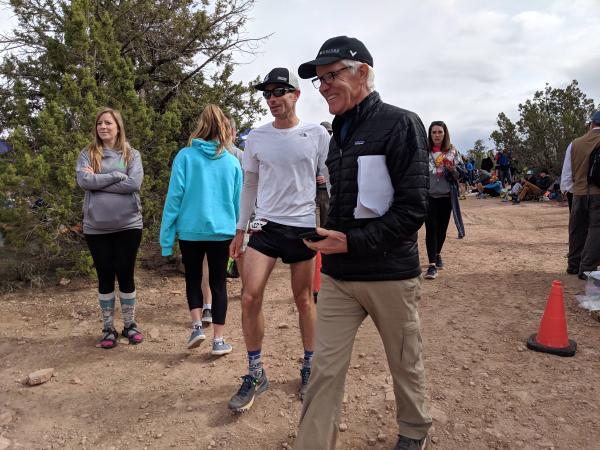
My dad crewing me at the mile 22 aid, early in the day
Gooseberry Point is a turnaround point in the course at mile 40 or so, with breathtaking vistas in every direction. There was no checkpoint, no hand stamp, no page to tear from a page to prove that you were there. It was the kind of place that I wished I had a camera… but most importantly, for me, it was the point that I determined I was leading the 100-mile race. A handful of runners reached the turnaround in front of me, but I noticed as they were coming inbound that they all had 100k bibs. At the next aid, I asked whether any 100-mile runners had passed through. Nope. I was winning.
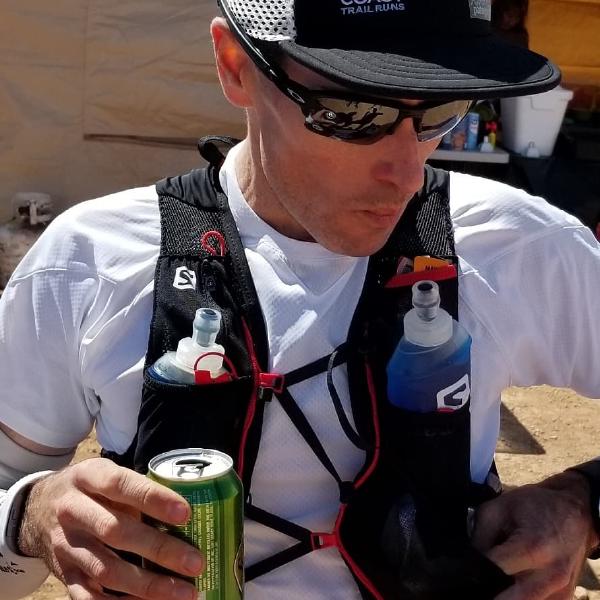
Chris refuels during the early miles of the race
I did not want to be winning. I still had 12+ hours to go. I had no idea where second place was in the field behind me. I hadn’t studied the second half of the course enough to know whether my pace predictions would be accurate. There were so many unknowns. Because of my lack of preparedness to be at the front, and the pain and fatigue I started to feel as I was 7 hours into the race, I felt a lot of varied emotions over the next 10 miles. I eventually decided that my best plan was to stick with the plan I had formed before the race. I pulled out my mp3 player, placed my earbuds in my ears, and turned on a playlist of hour-long music mixes to keep my mind occupied.
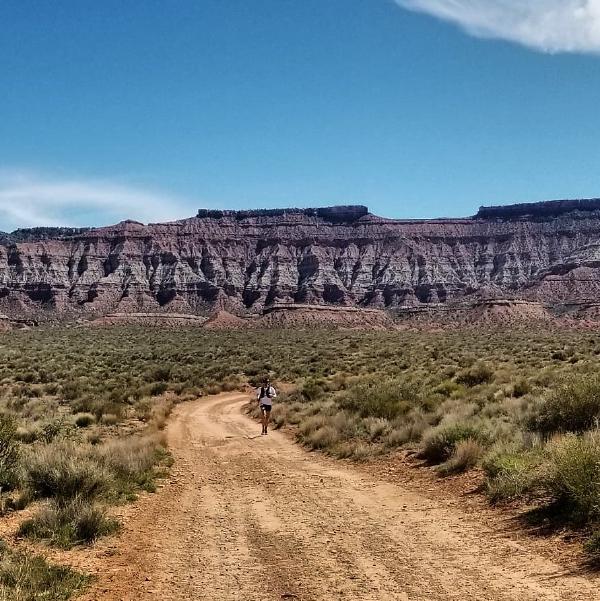
40 miles deep, I discovered I was winning the 100-mile race!
I wish I had some crazy stories to tell about the rest of the race, but (fortunately) I just kept moving at a steady pace. I had dark orange urine late in the afternoon, just after I saw my crew at mile 53. We all knew I was winning when I rolled into that aid station. That was the first time I’ve felt like a winner in an ultra… the entire crowd, everyone’s crew, aid station volunteers, etc. cheered me on as I changed my shoes and continued on the course. I knew I was getting dehydrated from the sun exposure, but I slowed down and focused on ingesting as much water and food as possible. I wanted to puke, but I kept it in. The afternoon and evening hours were all about consistent execution. I was able to pee every 2 hours, but it stayed at a dark yellow color. I kept focusing on hydration and maintaining my caloric intake. I was ingesting a delicate blend of oreos, nutter butters, pretzels, and fresh fruit. I drank only water for the entire race. I took one gel per hour to make sure I was getting glucose to my brain.
Until mile 80, I had no idea where second place was. I made the decision early that I didn’t want to know - I wanted to run my own race, and execute on my own schedule and plan, until the final hours. When I descended from Smith Mesa at sunset, I only had 20 more miles. As I refueled at the BMX Aid (mile 80), my dad pointed out second place descending from the mesa. We could see the headlight in the middle of the steep mountainside, which meant that I had a 20-25 minute lead.
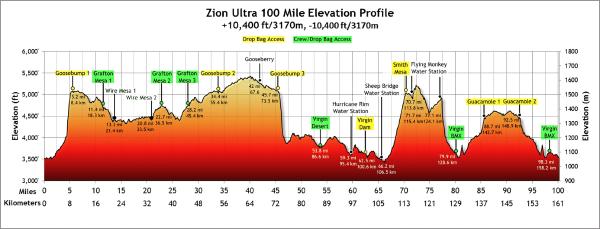
Zion 100 elevation profile
I was exhausted. Everything hurt. I could barely eat. I had the last big climb of the race ahead of me, a moderate dirt road incline to the Guacamole aid station. I had a short loop out from Guacamole, then I would return down the same dirt road and continue just two miles to the finish. The end was in sight! Knowing that second was in striking distance, but that second place probably did not realize I was departing the aid station, I made the decision to hammer the last climb and put a lot of time between me and second place. I did not want the race to come down to a sprint - I wanted to crush the spirit of second place at the moment they reached the Guacamole aid. I wanted them to realize that I opened my lead by several minutes during the climb, and I wanted them to think they had no chance to catch up. In reality, it was the only card I had left to play. I didn’t have the will in me to race to the end, but I knew that I could run that last climb for 4-5 miles.
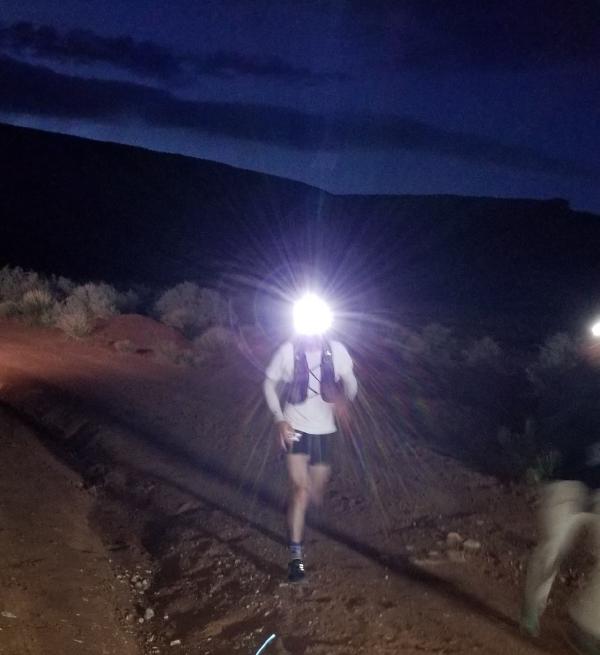
Crushing the night miles
Unsure that my strategy had an effect on second place, I was nervous about my slowing pace during the last 15 miles. I still kept moving as fast as I could, but moving quickly on uneven slickrock was impossible. The ground was never flat, and I lost sight of the course with every turn. It was mentally and physically exhausting. I fell and broke my hand open, dripping blood on my white shirt and the gray rock below.
Just as I was completing the slickrock loop to return to the Guacamole aid, I saw second place outbound for the same loop. My strategy had worked - I had a 40-minute lead at that point, with just 8 miles to go. There was no way he would catch me. We high-fived (with my bloody hand, sorry dude!). All I had to do was finish the race.
I took my time to the end. The biggest mistake I could have made at that point would have been to acutely injure myself. I kept up my hydration, ate what I could (not much), and kept my legs moving. I saw my dad and Bobby at mile 98. It was a small celebration - we knew I had the win in the bag! I gave them my pack, ate an oreo covered in peanut butter, and set out on the final two miles.
My headlamp died on the final two miles… but I guess that Petzl built in some kind of backup mode for this scenario? It went out, and I laughed at my current situation, then it kicked on again in a super-low setting. The low light sufficed to light my path for the final mile of dirt road. I cruised in to the city park of Virgin, UT at 1am on a Friday night, and I crossed the finish line to the sounds of exactly two people cheering and clapping for my accomplishment.
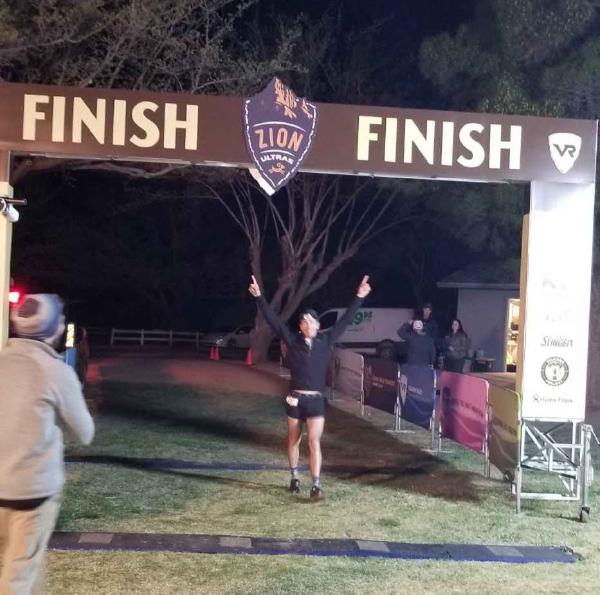
Crossing the finish line